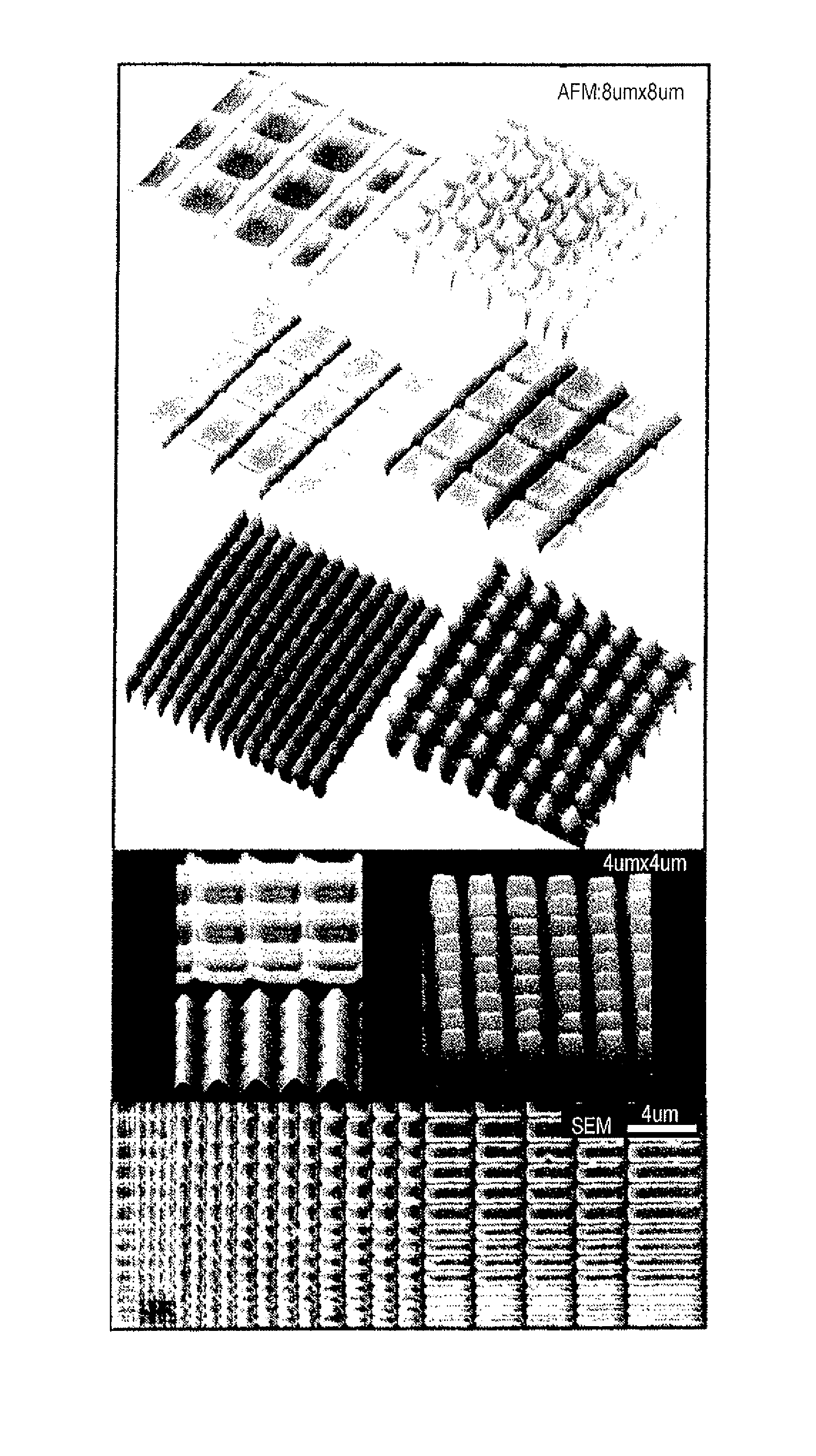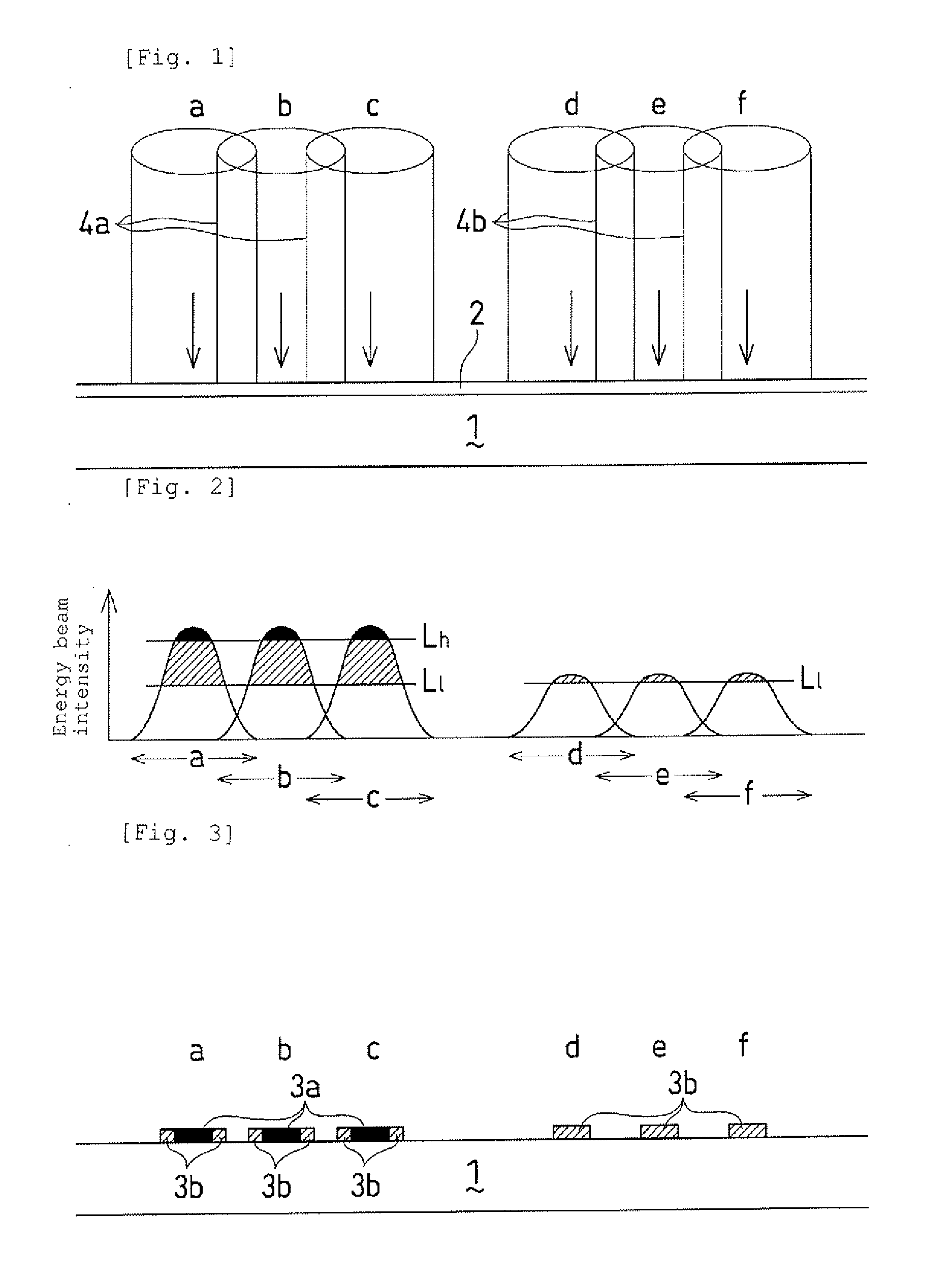Method of mask forming and method of three-dimensional microfabrication
a three-dimensional microfabrication and mask technology, applied in the field of three-dimensional microfabrication mask forming and three-dimensional microfabrication, can solve the problems of difficult general definition of blurring, process control and the like, and the limits of high-precision mask formation, etc., to achieve low cost and high accuracy
- Summary
- Abstract
- Description
- Claims
- Application Information
AI Technical Summary
Benefits of technology
Problems solved by technology
Method used
Image
Examples
first embodiment
[0054]In a first embodiment, as shown in the left side of FIG. 1, to a GaAs substrate 1, without removing a natural oxide layer 2 of As2O3, As2O, or the like formed naturally on its surface, by means of a publicly-known electron beam drawing device, an electron beam (energy beam) 4a was irradiated in a high vacuum toward the surface of this natural oxide layer 2 (step 1).
[0055]Irradiation of the above-described electron beam 4a was carried out with its beam diameter of 1 μm, an acceleration voltage of 50 kV or less, and the amount of line Dowes of 2.5×10−1 electron / cm, in a single line mode. Here, the amount of line Dowes of the electron beam 4a was controlled by appropriately changing the amperage and irradiation time of the electron beam.
[0056]Here, an irradiation interval of the electron beam 4a (a distance by which, after an electron beam was irradiated, this was translated to a line to be irradiated next) was 50 nm. Namely, the electron beam 4a was irradiated a plurality of tim...
second embodiment
[0074]In this second embodiment, as shown in the right side of FIG. 1, by irradiating an electron beam 4b onto a natural oxide layer 2 of a GaAs substrate 1 and carrying out heating completely the same as the above, a minute mask 3b with a 10 nm width as shown in the right side of FIG. 3 was formed. Here, irradiating conditions of the electron beam 4b were completely the same as those of the foregoing first embodiment expect for that the amount of line Dowes was provided as 2.5×109 electron / cm.
[0075]Then, by an MBE method, GaAs was selectively grown on the GaAs layer 1 of the side where the natural oxide layer 2 had been desorbed. Then, at the initial stage of diffusion, Ga atoms adhered to parts (mask 3b) where Ga2O3 had been formed (unlike the foregoing first embodiment), and by self-assembly around the same as a nucleus, GaAs grown crystals 5 were formed as shown in the right side of FIG. 4(a). Namely, the Ga2O3 (mask 3b) as a reformed natural oxide layer functioned as adsorptive...
third embodiment
[0080]In this third embodiment, onto a GaAs substrate 1, GaAs crystals were grown by self-assembly by means of a technique the same as that of the foregoing first embodiment or second embodiment, a high-density array structure was formed as in FIG. 4(a). Thereafter, Si as being a dopant was supplied as molecular beams. Then, as shown in FIG. 5, an n-channel was formed on a facet surface (crystal orientation (100) surface) of each GaAs grown crystal 5, and p-channels were formed on other facet surfaces (crystal orientation (n11) A surface, n is 3, for example) were formed.
[0081]By this method of the third embodiment, a large number of minute transistor structures could be formed by fewer steps. In other words, p-n control of a surface of each unit structure of a high-density array structure could be carried out in a lump.
PUM
 Login to View More
Login to View More Abstract
Description
Claims
Application Information
 Login to View More
Login to View More - R&D
- Intellectual Property
- Life Sciences
- Materials
- Tech Scout
- Unparalleled Data Quality
- Higher Quality Content
- 60% Fewer Hallucinations
Browse by: Latest US Patents, China's latest patents, Technical Efficacy Thesaurus, Application Domain, Technology Topic, Popular Technical Reports.
© 2025 PatSnap. All rights reserved.Legal|Privacy policy|Modern Slavery Act Transparency Statement|Sitemap|About US| Contact US: help@patsnap.com



